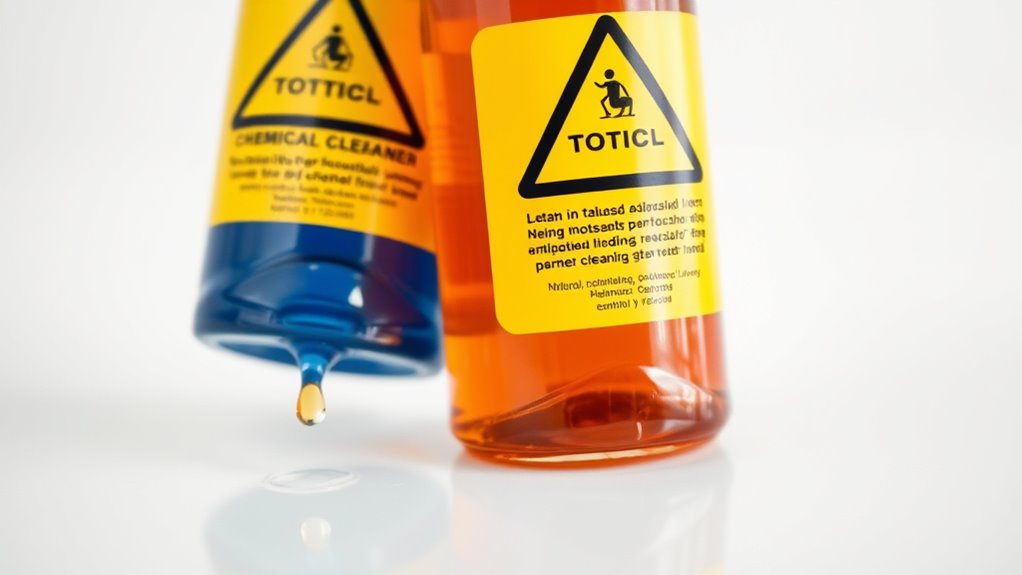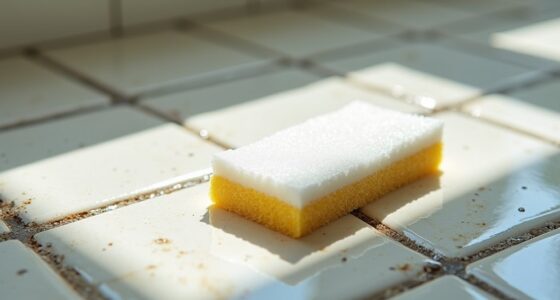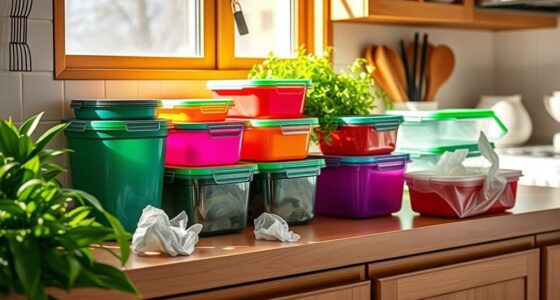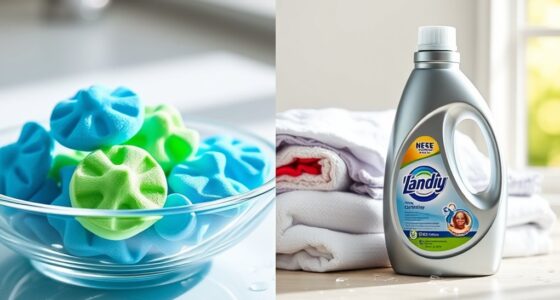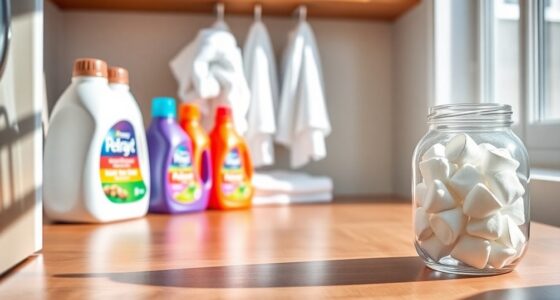Never mix bleach with ammonia or acidic cleaners, as it creates toxic chloramine vapors or chlorine gas that can cause serious respiratory issues. Combining different drain cleaners can lead to violent reactions and chemical burns, while mixing cleaning products without knowing their chemistry can release hazardous fumes. Always follow label instructions and avoid combining chemicals unless explicitly safe. If you want to stay safe and avoid dangerous accidents, it’s important to understand which combinations to steer clear of.
Key Takeaways
- Never mix bleach with ammonia to avoid toxic chloramine vapors harmful to respiratory health.
- Avoid combining bleach with acidic cleaners, as it releases dangerous chlorine gas.
- Do not mix different drain cleaners, especially those containing caustic soda or sulfuric acid, to prevent violent reactions.
- Always read and follow chemical labels to prevent hazardous reactions and ensure indoor air quality safety.
- Store cleaning chemicals separately and never mix unless explicitly instructed by product labels.
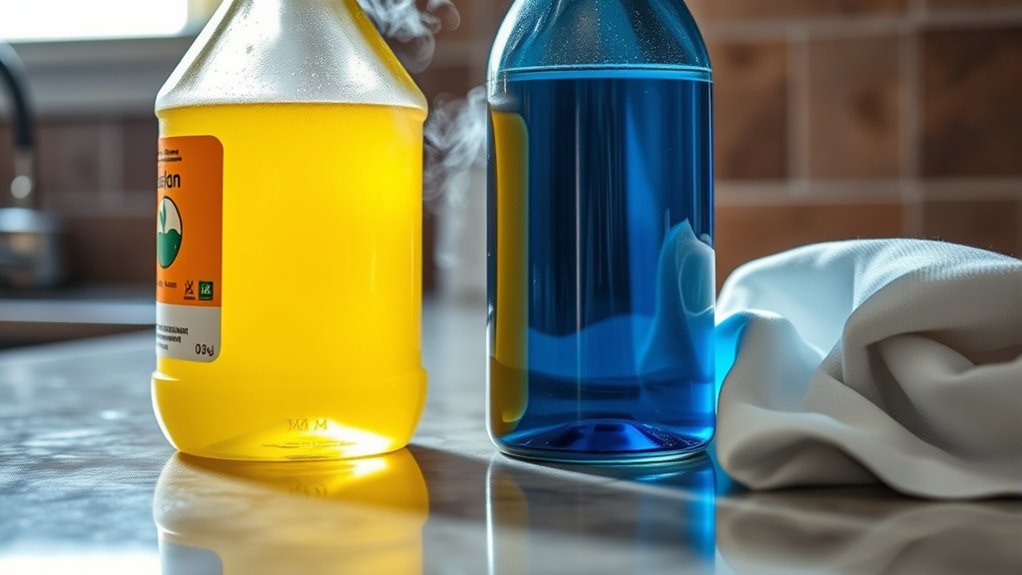
When it comes to cleaning your home, mixing certain chemicals can be dangerous, even deadly. Many household cleaning products contain powerful ingredients that, when combined improperly, can cause hazardous reactions. Understanding which chemicals to keep apart is essential to avoid accidents and health risks. Always read the labels and heed chemical warnings, as they are there for your safety. Ignoring these warnings can lead to serious injuries or worsen indoor air quality.
One of the most notorious combinations is bleach and ammonia. When mixed, these two create chloramine vapors, which are highly toxic and can cause respiratory issues, chest pain, and eye irritation. In severe cases, exposure can lead to pneumonia or fluid buildup in the lungs. The chemical warnings on bleach bottles highlight this danger clearly, but many people underestimate the risks or forget to check labels. Never combine bleach with ammonia-based cleaners or any product that contains ammonia, as the reaction releases hazardous gases that can harm your lungs and eyes instantly.
Another common mistake involves mixing bleach with acidic cleaners, such as vinegar or certain toilet bowl cleaners. When these acids meet bleach, they produce chlorine gas, which is extremely harmful if inhaled. Chlorine gas can cause coughing, throat irritation, and breathing difficulties. In high concentrations, it can be life-threatening. Always use these products separately and rinse surfaces thoroughly before switching to another cleaner. The chemical warnings on these bottles emphasize the importance of avoiding such combinations, but many overlook this advice in their rush to clean.
You should also steer clear of mixing different types of drain cleaners. Some contain caustic soda or sulfuric acid, which, when combined with other cleaners, can cause violent reactions or release dangerous fumes. These reactions can lead to chemical burns or respiratory issues if inhaled. Always use drain cleaners as directed, and never pour multiple products down the drain simultaneously. Labeling on these products warns of the dangers of mixing, so respecting those warnings is critical.
Frequently Asked Questions
Can Mixing Cleaning Chemicals Cause Long-Term Health Issues?
Mixing cleaning chemicals can cause long-term health issues because it increases your risk of chemical exposure and health risks. When you combine products like bleach and ammonia, toxic fumes form, which can damage your respiratory system and other organs over time. Always follow safety instructions and avoid mixing chemicals to protect your health. Proper use reduces health risks and keeps you safe during cleaning routines.
What Are Common Household Chemicals That Shouldn’t Be Combined?
You should never mix dish soap with vinegar cleaning, as it can create a foaming mess and reduce cleaning effectiveness. Avoid combining bleach with ammonia or vinegar, because it releases toxic fumes that can harm your respiratory system. Never mix bleach with other cleaners, especially those containing acids or ammonia, to prevent dangerous chemical reactions. Always read labels carefully and stick to safe combinations to protect your health and home.
How Do I Safely Dispose of Mixed Hazardous Cleaning Agents?
You should never pour mixed hazardous cleaning agents down drains, on the ground, or into trash bins. Instead, follow proper disposal methods by contacting your local hazardous waste facility, adhering to community guidelines, and using designated collection events. Always wear protective gear, keep chemicals in their original containers, and never attempt to neutralize or dilute hazardous waste yourself. Responsible disposal minimizes environmental impact and keeps you safe.
Are There Any Natural Alternatives to Chemical Cleaning Mixes?
Yes, you can use natural cleaning solutions like vinegar, baking soda, and lemon juice as eco-friendly alternatives. These ingredients effectively clean surfaces without harsh chemicals, making them safe for you and the environment. For example, vinegar disinfects, baking soda deodorizes, and lemon juice cuts through grime. Switching to these eco-friendly alternatives not only reduces chemical exposure but also promotes a healthier home, all while being gentle and effective.
What Are Symptoms of Chemical Poisoning From Improper Mixing?
Chemical poisoning symptoms are like alarm bells ringing loudly. If you’ve mixed cleaning chemicals improperly, you might experience symptoms such as coughing, difficulty breathing, or burning eyes. You could also notice dizziness, nausea, or chest pain—clear poisoning indicators. If you see these signs, seek fresh air immediately and contact medical help. Recognizing poisoning symptoms quickly can prevent serious health issues, so stay alert when handling cleaning chemicals.
Conclusion
Remember, mixing cleaning chemicals can be a recipe for disaster. Always read labels and follow instructions carefully, because you don’t want to play with fire or end up in a hazardous situation. When in doubt, keep things simple and stick to one product at a time. It’s better to be safe than sorry—no cleaning job is worth risking your health or creating a dangerous situation. Stay cautious, and your home will stay safe.
